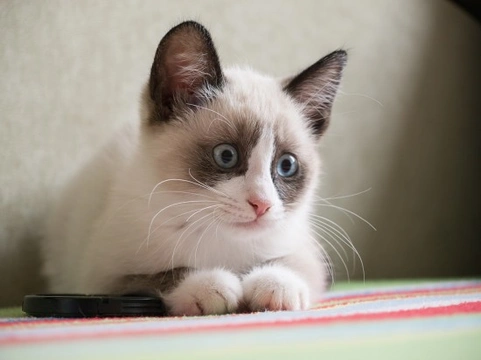
The history and breeding challenges of the uncommon Snowshoe cat
The Snowshoe cat is classed as a rare breed, which originated in the USA during the 1960’s. The first Snowshoes to be bred came about by mistake, when a breeder in Philadelphia with Siamese cats found herself with a litter of Siamese cats with white paws! Because this variant received some attention and was considered to be unusual and desirable, the breeder in question, Dorothy Hinds-Daugherty, set up a breeding programme to produce more of these white footed Siamese cats, which she originally called “Silver Laces.”
While the breed that we now call the Snowshoe has been around for over forty years, the breed is relatively uncommon, due to the challenges of reliably producing cats with white paws rather than other variant markings. The gene responsible for the white feet is recessive, meaning that it is not easy to reliably guarantee reproducing it within any litter.
In this article, we will look at the history of the breed in more detail, and why the breed remains uncommon and challenging to produce. Read on to learn more.
The history of the Snowshoe cat in more detail
Dorothy Hinds-Daugherty was a breeder of Siamese cats first and foremost, and the first three kittens to be born with the Snowshoe markings came as something of a surprise! In order to attempt to produce more Siamese cats with the white feet of the first litter, the breeder crossed seal point Siamese cats with bi-colour American shorthair cats, which produce litters with variable markings that did not possess the traditional colour points of the Siamese.
However, breeding those cats themselves back to Siamese cats re-introduced the colour points, along with the white paws, and the mission was accomplished. Hinds-Daugherty promoted her new breed, the Snowshoe, and it gained in popularity, but did not receive formal recognition as a breed in its own right at the time. Later, another breeder named Vikki Olander carried on attempting to breed further Snowshoe lines.
Vikki Olander produced the first uniform breed standard for the Snowshoe cat, and was successful in gaining recognition for the breed as an “experimental breed” with the American Cat Association, and the Cat Fanciers Federation. The breed failed to catch on at the time however, and by the late 1970’s, Olander was the only remaining Snowshoe breeder in America.
Eventually, two other breeders, Georgia Kuhnell and Jim Hoffman, and various others, joined the breeding programme, and helped to promote the popularity of the Snowshoe breed. The Snowshoe was subsequently awarded championship status with the Cat Fanciers Federation in 1983, and the American Cat Fanciers Association in 1990.
The Snowshoe’s popularity continued to grow, and in 1993, gained recognition from TICA, The International Cat Association.
Snowshoes in the UK
Within the UK, the first Snowshoe breeding programme began in 1986, but failed to gain a significant following. By 1998, just one breeder was left in the programme, with only five cats of the breed present within the UK. However, the breed has expanded slowly since that time, with the introduction of a senior stud male imported from Germany, and further colour and pattern variants being introduced to the breed lines in the UK.
After many years of work on breed lines and promoting the Snowshoe behind the scenes, the breed attained full breed status with the GCCF (Governing Council of the Cat Fancy) in 2013, and from that point onwards, the Snowshoe has been allowed to be shown up to championship level.
The challenges of establishing the Snowshoe breed
One of the issues that has led to difficulties promoting the breed and producing them in reasonable numbers is due to the challenges of creating a cat that both possesses the desired markings, and also conforms to the breed standard.
The white paws of the Snowshoe are caused by a recessive gene, which proves challenging to reproduce without significant inbreeding, and more than one recessive gene comes into play when you also take into account the other desirable markings of the Snowshoe as well as the white paws. The white paws themselves can be caused by either a gloving gene or a piebalding gene, both of which are challenging in terms of predicting their expression, and can cause the main part of the legs to be white, and not just the paws.
This means that out of all of the cats of the Snowshoe breed produced each year, few will conform fully to the breed standard and be of show quality, and many more of the litters produced will produce only pet-quality cats, with either too much or not enough white on the legs.
Achieving the perfect breed standard when working with a cross of a Siamese and an American shorthair is difficult in itself too, and this entire combination of factors means that the Snowshoe as a whole is rare, and show-quality cats of the breed are even rarer!



